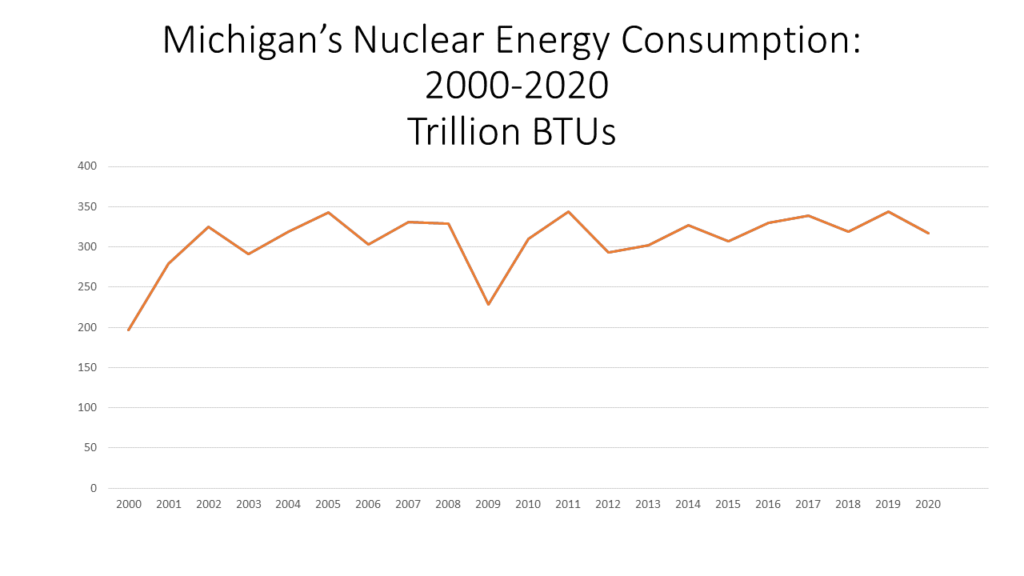The consumption and production of nuclear energy is not new in Michigan. In fact, according to the most recent data from Energy Information Administration, Michigan produced more nuclear energy in 2020 than any other kind of energy. At that time, Michigan had three functioning nuclear power plants- Fermi 2, Cook and Palisades. In May of 2022 though the Palisades Nuclear Power Plant, which is located on the west side of the state, ceased operations.
Now, however, Palisades’ operations might re-start. Several lawmakers in Michigan want the nuclear plant to re-open, both for energy and economic purposes. On Sept. 9, 2022 Gov. Gretchen Whitmer sent a letter to the US Department of Energy supporting the new owner of Palisades Power Plant’s (Holtec International) federal grant application to the Civil Nuclear Credit program. This program was established to save “premature” retirements of nuclear reactors due to financial hardships. While Michigan lawmakers, such as Gov. Whitmer, believe the nuclear plant is eligible for the program there are several groups, including the Michigan Sierra Club and Michigan Wildlife Conservancy that believe otherwise.
When the Palisades Nuclear Power Plant closed on May 20, 2022 it closed 11 days early because of the performance of a “control rod drive seal,” according to a press release from the Governor’s Office. It was on May 20 that its fuel supply ran out and the power purchase agreement with Consumers Energy expired. The environmental groups say that the plant isn’t eligible for the federal grant program.
Opponents say ineligibility stems from the fact the plant is in fact retired now, according to the Holland Sentinel, and the program is intended for plants that are still operating. According to the Nuclear Regulatory Commission, it has never received a request to return a nuclear plant to the grid after it has been permanently defueled. If Palisades becomes the first this could mean the 600 jobs lost when the plant closed could be brought back.
Proponents say economic development is a factor to consider when seeking to re-open the plant as well as the amount of energy produced and consumed. They argue its long-term effects on Michigan and beyond should also be considered.
Data is not yet available to determine how the closure has impacted the state’s energy production and consumption for 2022, but according to the Governor’s Office more than 800 megawatts of nuclear energy was produced by the Palisades plant on an annual basis. And, as the charts below show, the amount of nuclear energy produced in Michigan is equal to the amount consumed.
According to the Energy Information Administration, in 2021, coal provided the largest share of Michigan’s electricity net generation (32%), followed by nuclear energy (30%) and then natural gas-fired power (27%). The data in BTUs was not available for 2021, but the charts below show that in 2021 316.7 trillion BTUs of nuclear energy was both produced and consumed in Michigan.
In the last 20 plus years the amount of nuclear energy produces, and consumed, has grown slightly (except for a production dip in 2009). In 2000, 196.9 trillion BTUs of nuclear energy was produced and consumed in Michigan, and by 2020 that number increased to 316.7 trillion BTUs. It will decline substantially now with the closing of Palisades, a loss of roughly 800 megawatts.


•It does not produce emissions (nuclear energy produces energy through fission);
•It utilizes a relatively small footprint to produce energy than others sources (more than 3 million solar panels are needed to produce the same amount of power as a typical commercial reactor or more than 430 wind turbines, according to the Office of Nuclear Energy);
•Nuclear fuel is dense so it produces minimal waste.
Opponents support the decommissioning of plants, including Palisades. Their reasoning considers first, the radioactive waste that remains on-site. The waste can remain on site for decades and the storage and removal of the waste is a concern because of potential spills, groundwater contamination and more.
In addition, the risk of an accident at a nuclear plant also causes grave concern for those in the plant and the surroundings of the nuclear power plant, including long-term radioactive pollution of the area—just look at Chernobyl. Recent threats to Ukrainian nuclear plants raise the specter of new ways that nuclear disasters could occur. Other concerns are that the mining of uranium is controversial, nuclear plants can be viewed as national security threats, and these plants cost an exorbitant amount to build.
With the pros and cons to nuclear energy fairly well known, now the federal government, the new Palisades’ Nuclear Power Plant owner and the State of Michigan must decide whether redeveloping Michigan’s nuclear energy supply is worthwhile.














